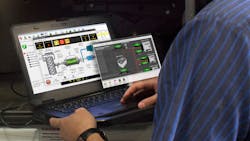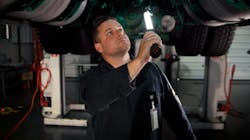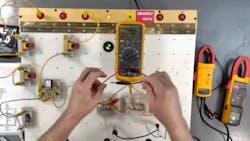Heavy-duty vehicles are constantly evolving, relying on more complex sensors, communication wires, and electronics to operate. As electronics in vehicles have increased, so have the number of issues a truck can experience. Maintenance is drastically different from just five to 10 years ago, and even basic electrical issues can baffle technicians. And as electric vehicles come to market, the next decade will bring even more challenges.
The biggest challenge is that unlike a brake rotor or bent tie rod, technicians need more than their eyes to see what’s wrong.
“It’s one of those things you can’t physically look at and say, ‘You know, that looks broken,’” Mike Oliveri, technical training specialist for Isuzu Commercial Truck, explained during a virtual training session hosted by ASE Education Foundation. He and colleague Justin Ridings, another Isuzu technical training specialist, showed how to perform voltage drops, walked through circuit differences, and showed how to use common testing equipment the right way. The webinar was called “Enhancing Your Electrical Diagnostic Skills,” and for technicians today, that is a never-ending battle and one that requires continuous dedication and training.
What’s more, there are a vast number of things that can go wrong. “Electrical issues step from minor corroded connections to complicated multiplex issues where the computers are having problems talking to each other,” said Jack Werner, director of strategic partners for Western Technical College.
Duane “Doc” Watson, field service technical trainer for Bosch, said the complexities on today’s equipment are endless. “The old standard is the typical electrical issues that technicians have been dealing with for years, such as corrosion, high resistance lowering the amperage, vibrations causing connection problems, and countless other issues,” he said. “Now, it’s even more complex.”
Interconnectivity and increased reliance between multiple components has complicated the diagnostic process. “Engines are no longer standalone components. There is a dependency on other components to perform the job effectively,” explained Lee Lackey, product manager at Noregon Systems.
With integrated powertrains, virtually everything works together in some way. “Thus, technicians need to be better informed about how all the systems interact and affect one another,” said Jake Schell, associate product manager for Mitchell 1’s Commercial Vehicle Group. “This means technicians must have access to service information to understand, diagnose, and repair electrical concerns.”At the same time, many technicians lack a good foundation in electrical diagnostics, said Keith Littleton, president of K&D Technical Innovations. “It makes it look like these trucks are impossible to fix, and that isn’t the case,” he said. “Normally, 80% of the problems are simplistic.”
Because of the complexity and tendency to over-complicate repairs, technicians will need to upgrade their skill sets even more. Here are some best practices to help.
Diagnosing electronic issues
To be effective, technicians need a good basic understanding of electronics, how to use a schematic, how to use a multimeter correctly, how to identify wiring issues, and how to test wiring. “A more advanced technician needs to understand laptop diagnostics,” Werner emphasized.
Many of today’s technicians weren’t faced with the advanced electronics when they went through their training. “I had a technician once tell me, ‘I’m a mechanic and not an electrician.’ That gentleman is now retired because he didn’t want to learn it,” Werner said.
Karl Geiger, training manager for W.W. Williams, said many technicians need additional instruction. “They don’t know how to read the meter. They don’t understand circuitry,” he said, adding that on the heavy-duty side, he has people coming in who can’t read decimals, which creates a challenge.
Physically inspecting a battery can uncover many common issues, such as corrosion or battery terminals blocked with dust, paint, or some other foreign substance.
Noregon’s Lackey recommends that technicians focus on the truck holistically and examine if any individual ECUs produce a discrepant number of electrical faults or erratic data/parameter values. “If so, focus some of your diagnostic efforts on that controller to try and determine why it appears to be complaining. You may find something like water or significant corrosion in a connector causing issues,” he said. “It’s important not to get caught up in a single fault and to also look at the big picture because solving the root cause of one fault could correct them all.”
While technicians need to receive adequate training on the increasingly complex systems, Schell said it is unrealistic to expect them to know everything about a powertrain system that is constantly evolving, making diagnostic tools beneficial.
Scan tools are regularly updated with software designed to keep up with the increasingly complex vehicles, Bosch’s Watson said. “By using a scan tool, such as the ADS 625X or the ESI Heavy Duty Truck Diagnostic Solution, technicians can pinpoint precisely where the issue lies within the vehicle,” he said.
Certain technical issues, such as vibrational problems causing loose or intermittent poor connections, can impact readings or give false readings, Watson said. “The technician then must determine whether the problem is coming from a wiring issue or if there’s something wrong with the connector,” he noted.Lackey said the wiggle test is one of the most often used bidirectional tests in JPRO each month. “The wiggle test allows the technician to physically wiggle a wire or harness and detect changes in data values or activation of faults across multiple ECUs to help pinpoint the location of a communication error,” he explained.
Some issues can appear as communication errors when they are not.
“Often, a truck component needs a reflash to correct a problem that may initially seem to be an electronic issue,” Lackey said. “This can lead to a lot of wasted time for technicians, so be sure all ECU software is up to date when performing diagnostics.”
Truck communication issues can be tricky to solve, so Lackey recommends looking at the count associated with a fault. “If a fault has a high count, it can mean that the condition causing the fault is coming and going with high frequency,” he said. “This can point to a variety of issues causing the problem, such as comms, vibration, loose connectors, et cetera.”
Dynamic testing
Working on any electrical component starts with understanding electricity—the movement of electrons within the conductors that make up a truck’s circuits—and its related elements, Isuzu’s Ridings explained during the ASE webinar. Voltage is the electrical potential or pressure, and amperage, or amps, is the movement of electrons. Another critical factor in electrical circuits is resistance. “Without that, there would be an uncontrolled amount of electron flow,” he explained.
Instructors typically teach new technicians to measure voltage and resistance, but that can leadto misdiagnosis, so Littleton advocates dynamic testing to measure amperage. “You can’t measure amperage statically,” he said.
Testing the amperage of a circuit will help technicians understand how hard that circuit is working by displaying a quantified value for electron flow, said Isuzu’s Oliveri. “This is critical when you’re testing any part of your electrical system,” he noted.
Dynamic testing requires tools, such as oscilloscopes, that can look at electronics and communication at the same speed that they’re happening. “These scopes have been around for a long time, but they have become very advanced with what they can do,” Littleton said.
Oscilloscopes are best used by advanced technicians who understand electronics, Geiger said. “Some don’t know how a relay works or what the numbers on the meter mean,” he said.
George Arrants, VP of the ASE Education Foundation, compared oscilloscopes to medical devices. “Every one of us has watched shows with paramedics or doctors reading a meter with a bunch of squiggly lines. The oscilloscope is the same thing we use on a vehicle,” he explained. “Knowing how to read the squiggly lines lets you know who is communicating with whom, what they’re saying, and if the message is clear or corrupt.”
Lackey also recommends technicians test the voltage on the battery and the charging system. “If there is poor voltage or charging system performance, then any vehicle system these components power will likely be affected,” he said.The voltage drop test, which should be done with a functional, active circuit, is one of the most misunderstood tests in the electrical field, Oliveri said. “If you have a high voltage drop on the power source or the ground side of the circuit, the components that you are trying to operate are going to be affected by it,” he said. “Corrosion at the terminal contacts; undersized wiring; loose, dirty, or corroded grounding points; or higher excessive resistance within a wire are just a few things that you could come across.”
The voltage drop test can expose a lot of problematic areas within a circuit, whether they’re high voltage or low voltage. “Corrosion doesn’t discriminate. It can occur at any given point in a circuit,” Ridings noted.
Before diving into any electrical circuit diagnostics, technicians must review schematics, which are essentially a roadmap that details the route electrons should be taking. “It is so very critical that we study and understand the schematics before we get into disconnecting and testing at different points in the circuit,” Ridings said, adding that schematics outline what is supposed to happen when a switch is flipped.
Wiring diagrams vary by make and model. “Sometimes they even change wiring diagrams mid-year,” Littleton said. “Technicians have to have the wiring schematic for every vehicle.”
Mitchell 1 recently updated its TruckSeries repair information platform with an Advanced Interactive Wiring Diagrams feature to help technicians navigate these mazes of lines and symbols. Technicians can also search for and home in on what they need to work on to improve accuracy and efficiency.
“As a technician, I can very quickly focus in on what I want to see. I can dim the rest of the wires so that I can focus even better,” explained Ben Johnson, Mitchell 1 director of product management. “I can zoom in and see what I’m interested in looking at.”
No matter how complex a system gets, remembering to adhere to the basic diagnostic procedures will always aid technicians in properly diagnosing and resolving electrical issues. Schell said it is important for technicians not to jump to conclusions or overlook preliminary tests that need to be done before performing the trouble code testing steps. “These preliminary steps typically assure that the conditions and voltages needed for system operation are present. It is completely possible that a trouble code can be resolved in verifying the preliminary tests,” he explained.
Increased adoption of EVs
The transition to EVs will bring added complexity, and technicians will need to have additional training and the right tools. “When we look at new electric vehicles, some of the skills are basic, and technicians will need foundational skills. Since we’re dealing with higher voltages, there are safety aspects, and you will need tools to handle that current. But if technicians don’t possess the skills currently with a vehicle with an internal combustion engine, they won’t get smart overnight,” Arrants said.
The American Trucking Associations’ Technology & Maintenance Council Technician and Educator Committee Electrified Vehicle Technician Training Task Force is evaluating the need for training guidelines to support electric commercial vehicle fleet maintenance operations, and for training requirements for EVs in technician school curriculum programs.
“That could mean refining existing training or creating completely new training,” said Jack Legler, technical director at TMC.
The committee’s eventual work product may be either an information report, which would take about a year to produce, or a proposal for a recommended practice. That could take about two years to produce.
“In general, you need to be looking at dealing with control circuitry, battery maintenance, charger maintenance, control systems that involve electronics, and high-voltage circuits,” Legler said.
OEMs are investing in training to help prepare technicians. In April, Daimler Truck North America expanded its Detroit Service Training Center, which will be used to train technicians in electric powertrain service, battery maintenance, and full truck repair.
“For the trucking industry to successfully transition to zero-emission vehicles, technicians need to know how to diagnose, service, and maintain new technology in order to keep our valued customers running with maximum uptime,” said Matt Pfaffenbach, head of operations, Detroit Powertrain.
Kenworth also offers a comprehensive EV technician training and certification program as part of its efforts to prepare Kenworth dealerships to service electric vehicles. As part of the program, Kenworth technicians must complete a seven-course curriculum on service systems, electrical principles, electrical systems, electrical systems II, cab and chassis electronics, electric vehicles systems, and advanced electric diagnostics.
While most EVs require the same tools for repair as an ICE vehicle since they still have tires, brakes, A/C systems, and other standard parts, technicians must have the right tools to service an EV battery, said Jennifer Grabowski, a product manager for Bosch.
This includes things like upgrading service jacks and lift equipment to handle the additional weight with EV vehicles, a charging station in-house for servicing, as well as high-voltage gloves and insulated versions of existing tools. Technicians will also have to pay close attention to the CAT rating and the rating of tools when moving to EVs or hybrids, and knowing how to use a tool like a scope or a multimeter will go from a nice skill to have to a required one.
“Now, more than ever, regular training on new vehicle standards and specialty tools is the most beneficial way that fleet managers and technicians can ensure that they’re up to speed on new systems and able to address any issues that they may encounter when conducting diagnostics or a repair,” Bosch’s Watson said. “Technicians are challenged with new, complex systems that could potentially create problems that certain technicians have never encountered before.”
Watson said technicians can face EV-related challenges head-on with proper training and the right tools. One challenge technicians might experience is experiencing difficulty when trying to duplicate a problem with a truck.
“This is because EMI waves penetrate wiring and interfere with internal signals, which sometimes only happens under certain conditions and cannot always be replicated in the shop,” he explained. “It doesn’t mean that there isn’t an issue with the vehicle. It means that figuring out the issue will be more complex and uncommon.”
Because of the high voltage associated with EVs, technicians will need to learn how EVs operate and the safety steps to be taken before diving into diagnostics and repair. “Electric truck batteries can be lethal and should be treated as such,” Noregon’s Lackey said. “Fleets and service centers must ensure any technician working on an EV is certified to do so while also dedicating certain bays to EVs and only allowing certified technicians in those bays.”
Technicians also should undergo training for decommissioning batteries, testing insulation levels, and even recognizing and responding to others in the shop working on an electric vehicle.
Staying up to date
All technicians and fleet owners need to stay up to date on the industry, whether they’re planning to transition to EVs or not. “Vehicles are becoming more and more complex every day, and it’s crucial that technicians are up to speed on any issues that may come their way,” Watson said. “Reading articles from industry outlets, studying new tool functions, and investing in training will set these technicians up for success.”Lackey recommends regular training should include OE-level courses and certifications, as well as training on aftermarket diagnostic tools, to keep up with the latest features and coverage updates. “Without exception, if a service bulletin is released for a truck that you service or operate, read it,” he said. “Service bulletins and recalls can save hours of misdiagnosis when the manufacturer either recalled a part or announced a software update to patch an issue.”
Tools also need to be kept current. “Most specialty and diagnostic tools are regularly updated with new software, and it’s vital that technicians install these updates in real time,” Grabowski said.
ATA has published recommended practices for calibrating, using, and storing test equipment. “It is important for technicians to follow this advice and constantly test their test equipment. Ensure tools like multimeters are providing accurate readings or that your voltage pen is detecting voltage before using them in a maintenance procedure,” Lackey emphasized.
Technicians tend to forget to remove batteries from their electronic diagnostic tools and specialized tools when not in use, Bosch’s Watson said. “These types of devices that are not used daily, leaving the battery in them could potentially lead to corrosion, ruining the tool altogether. Removing the battery from these tools can be cost-efficient for a fleet over time,” he explained, adding that technicians need to avoid wrapping cables around the tool and should ensure external surroundings cannot damage the tool.







